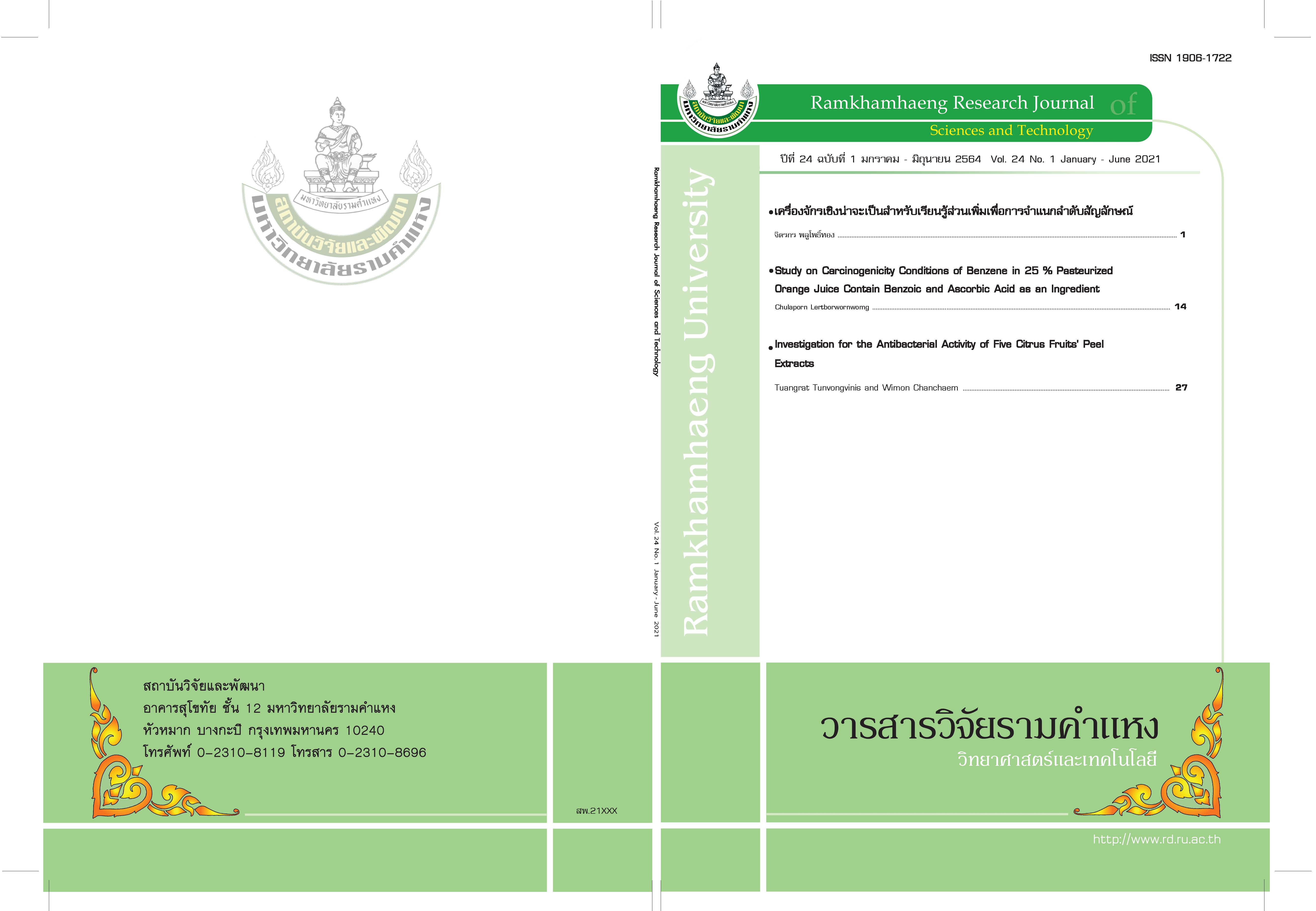การศึกษาสภาวะการเกิดสารก่อมะเร็งเบนซีนในน้ำส้ม 25 % พาสเจอไรส์ที่มีกรดเบนโซอิกและกรดแอสคอร์บิกเป็นส่วนผสม
Main Article Content
บทคัดย่อ
งานวิจัยนี้มีวัตถุประสงค์เพื่อศึกษาความเป็นไปได้ในการเกิดเบนซีนที่สภาวะแตกต่างกันในน้ำส้มพาสเจอไรส์
25% ซึ่งได้แก่ ปริมาณกรดเบนโซอิก และกรดแอสคอร์บิกทั้งชนิดเดี่ยวและแบบผสม ค่าพีเอชของผลิตภัณฑ์ อุณหภูมิ
และระยะเวลาการให้ความร้อน สภาวะการเก็บรักษา (อุณหภูมิ เวลา และแสงสว่าง) โลหะหนัก และ สารจับโลหะหนัก
ผลการวิจัยพบว่าการเติมโซเดียมเบนโซเอต และ กรดเบนโซอิก 200 ppm และ 120 ppm ตามลำดับ ในผลิตภัณฑ์ที่มี
pH 3.7 ฆ่าเชื้อที่อุณหภูมิ 100 oซ นาน 10 นาที เก็บรักษาที่อุณหภูมิ 30 oซ นาน 24 ชั่วโมงตรวจไม่พบเบนซีน แต่พบ
เบนซีนปริมาณสูงสุดในผลิตภัณฑ์ที่มี pH เท่ากับ 2 ปริมาณการพบเบนซีนในผลิตภัณฑ์ เพิ่มขึ้นจาก 0 เป็น 5.6 ppb
ตามค่า pH ที่ศึกษาระหว่าง 3.7 - 2 ตามลำดับ การเพิ่มอุณหภูมิพาสเจอไรส์จาก 90 - 100 oซ นาน 20 นาทีพบเบนซีน
เพิ่มขึ้นจาก 0 - 8.82 ppb ตามลำดับ สภาวะการเก็บที่อุณหภูมิสูง (45 oซ) เร่งการเกิดเบนซีน มากกว่าระยะเวลาเก็บ
แสงสว่างไม่มีผลต่อปริมาณเบนซีน สารโซเดียมเบนโซเอตร่วมกับกรดแอสคอร์บิกเร่งการเกิดเบนซีนมากกว่าสารเพียง
สามารถช่วยลดการเกิดเบนซีนได้
Article Details
มหาวิทยาลัยรามคำแหง
เอกสารอ้างอิง
Benzoate in Model Systems by Proton Transfer Reaction-Mass Spectrometry, International J. of
Mass Spectrometry. 275(1-3): 117–121.
ATSDR (Agency for Toxic Substances and Diseases Registry). 2018. Toxic Substance Protal : Benzene(CAS
ID # : 71-43-2). https://www.atsdr.cdc.gov/substances/toxsubstance.asp?toxid=14.
Casado, F.J., Sanchez, A.H., de Castro, A., Rejano, L., Beato, V.M. and Montano, A. 2011. Fermented
Impact of Additives on Quality Parameters,” J. of Agricultural and Food Chemistry. 59(6): 2403-
2409.
Central Laboratory (Thailand) Co.,Ltd., 2010. In House Method based on J. of. Chromatography A1035
(2004) 17-22 and detected by GC/MS with Headspace Technique.
Chang, C. and Ku, K. 1993. Studies on Benzene Formation in Beverages. J. of Food and Drug Analysis. 1 :
385-393.
Codex Alimentarius, FAO/WHO Foods Standards. 2017. Food Additive Group Details : Phosphates
. http://www.fao.org/gsfaonline/groups/details.html?id=18).
Cvetkovic, B.R. and Jokanovic, M.R. 2009. Effect of Preservation Method and Storage Condition on Ascorbic
Acid Loss in Beverages. BIBLID: 1450-7188. 40,1-7.
Dos Santos, V.P.S., Salgado, A.M., Torres, A.G. and Pereira, K.S. 2015. Review Article: Benzene as a
Chemical Hazard in Processed Foods. International J. of Food Science., p. 1-7
FDA (Food and Drug administration). 2013. Notification of the Ministry of Public Health (No.356) on Beverage
in Sealed Container, Ministry of Public Health, Thailand.
Gardner, L. K. and Lawrence, G. D. 1993. Benzene production from decarboxylation of benzoic acid in the
presence of ascorbic acid and a transition-metal catalyst. J. of Agricultural and Food Chemistry.
41(5): 693-695.
Igoe, R.S. and Hui, Y.H. 2001. Dictionary of Food Ingredients 4th ed. USA: An Aspen Publication. In House
Method based on J. of Chromatography A 1035 (detected by GC/MS with Headspace Technique.
2004. 17-22.
IARC (International Agency for Research on Cancer). 2018. IARC Monographs on the Evaluation of
Carcinogenic Risks to Humans. World Health Organization http://monographs.iarc.fr/ENG/Classification/.
Kafkas, E., Kosar, M., Turemis, N. and Baser, K.H.C. 2006. Analysis of Sugars, Organic Acids and Vitamin C
Contents of Blackberry Genotypes from Turkey. Food Chemistry 97 : 732-736.
Lange, M.W., Ommen, J.G.V. and Lefferts.,L. 2002. Deoxygenation of Benzoic Acid on Metal Oxides, 2
. Formation of Byproducts. Applied Catalysis A : General, 231 : 17-26.
Lawrence, J. 2010. Vitamin C : Stability and Quantitative Estimate of L-Ascorbic Acid. http://www.uwsp.edu/
chemistry/jlawrence/Content/Chem%20260%20Content/Chem%20260%20Labs/Vitamin%20C%20
Lab.pdf. University of Wisconsin-Stevens Point.
McNeal, T.P., Nyman, P.J., Diachenko, G.W. and Hollifield, H.C. 1993. Survey of Benzene in Foods by Using
Headspace Concentration Techniques and Capillary Gas Chromatography. J. of AOAC
International. 76 (6) : 1213-1219.
Medeiros, V.R., De, M. B., Andjelkovic, M., Canfyn, M., Van, O.I. and Van, L, J. 2011. Factors Influencing
Benzene Formation from the Decarboxylation of Benzoate in Liquid Model System. J. Agr. Food
Chem. 59(24): 12975-12981.
Morsi, R.M.Y., EL-Tahan, N.R. and El-Tobgy, K. 2012. Probability of Benzene Forming in Egyptian Non-
Alcohol Carbonated Soft Drinks,” Australian J. of Basic and Applied Sciences. 6(3): 271–278.
Nyman, P.J., Wamer, W.G., Begley, T.H., Diachenko, G.W. and Perfetti, G.I. 2010. Evaluation of accelerated
UV and Thermal Testing for Benzene Formation in Beverages Containing Benzoate and Ascorbic
Acid. J. of Food Science. 75(3) : 263-267.
Techakriengkrai, I. and Surakarnkul, R. 2006. The Analysis of Benzoic Acid and Sorbic Acid in Thai Rice
Wines and Distillates by Solid-Phase Sorbent Extraction and High-Performance Liquid
Chromatography. J. of Food Composition and Analysis. 20: 220-225.
William, H. 2002. Official Method of Analysis of AOAC International. 17th ed. Gaithersburg, Md : Washington DC.
http://www.ehow.com/facts 5007478-what-disodium-edta.html. Retrieved March 5, 2010.
http://www.george-eby-research.com/htm/stability-constants.htm.Stability Constants of Various Metal Chelates
. Retrieved January 25, 2011.
https://www.fda.gov/food/ingredientspackaginglabeling/foodadditivesingredients/ucm091048.htm. Food Additive
Status List. U.S. Food & Drug Administration. Department of Health and Human Service.Retrieved
April 20, 2018.


